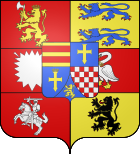House of Oldenburg
| House of Oldenburg | |
|---|---|
 | |
| Country | Grand Duchy of Oldenburg, Russian Empire, Kingdom of Denmark, Kingdom of Norway, Kingdom of Sweden, Kingdom of Greece, Duchy of Schleswig-Holstein |
| Founded | 1448 |
| Founder | Christian I |
| Current head | Christoph, Prince of Schleswig-Holstein |
| Final ruler | Russia: Nicholas II of Russia (1894–1917)
Sweden: Charles XIII of Sweden (1809–1818)
Oldenburg: Friedrich August II (1900–1918)
Schleswig-Holstein: Christian IX (1864)
Augustenborg: Albert (1921–1931) |
| Titles | |
| Estate(s) | Oldenburg, Russia, Denmark, Norway, Sweden, Greece, Schleswig-Holstein |
| Deposition | Russia: February Revolution 1917
Sweden: 1818 (line extinct)
Greece: Greek military junta of 1967–1974 1973
Oldenburg: German Revolution of 1918–19 1918
Schleswig-Holstein: Second Schleswig War 1864
Augustenborg: 1931 (line extinct) |
| Cadet branches | |
The House of Oldenburg is a North German dynasty and one of Europe's most influential Royal Houses.
It first became royal when Count Christian I of Oldenburg became chosen King of Denmark in 1448, and has been the Danish Royal House ever since. After some hiatus, King Christian I was also elected King of Norway.
Marriages of medieval counts of Oldenburg had paved the way for their heirs to become kings of various Scandinavian kingdoms. In 14th century, through marriage with a descendant of king Valdemar I of Sweden and of king Eric IV of Denmark, a claim to Sweden and Denmark was staked, since 1350.
At that time, its competitors were the successors of Margaret I of Denmark. In 15th century, the Oldenburg heir of that claim married Hedwig of Holstein, a descendant of Euphemia of Sweden and Norway and also a descendant of Eric V of Denmark. Since descendants better situated in genealogical charts died out, their son Christian (the abovementioned) became the king of all the three kingdoms of whole Kalmar Union. The House of Mecklenburg was its chief competitor regarding the Northern thrones, and other aspirants were e.g. the Duke of Lauenburg. Different Oldenburgine branches have reigned in several countries, as this selective chart shows:
- The main line
- Kings of Denmark (1448–1863),
- Kings of Norway (1450–1814),
- Kings of Sweden (1457–1464, 1497–1501 and 1520–1521),
- Dukes of Schleswig and Counts of Holstein (1460–1544),
- Dukes of Schleswig and Holstein ruling only part of the provinces (1544–1721/1773)
- Dukes of Schleswig (1721–1864) (ruling the entire province)
- Dukes of Holstein (1773–1864) (ruling the entire province)
- Holstein-Gottorp
- Dukes of Holstein-Gottorp (1544–1739)
- Holstein-Gottorp
- Holstein-Gottorp-Romanov (commonly still called Romanov).
- Holstein-Gottorp (Swedish branch), extinct.
- Kings of Sweden (1751–1818)
- King of Norway (1814–1818)
- Holstein-Gottorp (Swedish branch), extinct.
- Holstein-Gottorp (Grand ducal branch)
- Dukes, later Grand Dukes of Oldenburg (1773–1918)
- Holstein-Gottorp (Grand ducal branch)
- Schleswig-Holstein-Sonderburg-Augustenburg, extinct.
- claimant Duke of Schleswig-Holstein in 1863
- Schleswig-Holstein-Sonderburg-Augustenburg, extinct.
- A member of this branch is the Duke of Edinburgh, so it will also be reigning in the Commonwealth realms upon the ascension of his heirs, where it will be called Windsor.
See also
- List of rulers of Oldenburg
- List of consorts of Oldenburg
- List of Rulers of Schleswig-Holstein. Contains more information about the partitions of Schleswig and Holstein
- Coat of arms of Oldenburg
External links
- The House of Oldenburg - more specific genealogy
